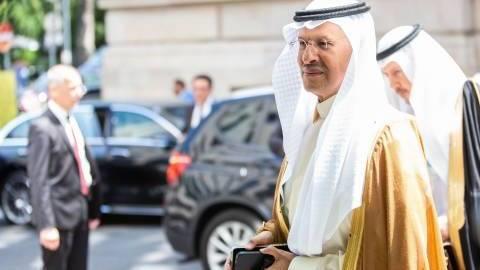OPEC+ Meeting Brings Deeper Saudi Cuts
Date
6/5/2023 10:06:16 PM
(MENAFN- ING) It hasn't been an easy
OPEC+ meeting for members. The group failed to come to an agreement on
deeper cuts, but production targets have been set for 2024 and voluntary cuts were extended. The Saudis have also decided to make further voluntary cuts In this article what was agreed? what does it mean for the market? why are we seeing cuts now?

Saudi Arabia's Minister of Energy Prince Abdulaziz bin Salman built expectations for further supply cuts ahead of the OPEC+ meeting What was agreed? The OPEC+ meeting was eventful. Heading into the meeting the expectation was that the group would announce further supply cuts – which was easier said than done. As Saudi Arabia struggled to convince other members to make deeper cuts, the group instead agreed to put in place a production target of 40.46MMbbls/d for 2024. This is lower than the 41.86MMbbls/d production target set back in October last year, which runs from November 2022 to December 2023.
In addition to setting production targets for next year, members who announced voluntary supply cuts amounting to 1.66MMbbls/d back in April made the decision to extend them through to the end of 2024.
The action taken by OPEC+ does little to help solve immediate concerns over demand. As a result, Saudi Arabia announced that it would make a further voluntary supply cut of 1MMbbls/d for July, which would leave Saudi output at around 9MMbbls/d. There's also potential for this additional voluntary cut to be extended if needed.
What does it mean for the market? In the lead-up to the meeting, Saudi Arabia's Minister of Energy Prince Abdulaziz bin Salman built expectations for further supply cuts – and it was therefore crucial that the group came away from the meeting with a cut of some sort. The extension of supply cuts through until the end of 2024 should not change the outlook drastically. However, the supportive factor in the immediate term is the further voluntary cut from Saudi Arabia. This should provide some limited immediate upside for the market, and it should also reinforce Saudi Arabia's commitment to try to put a floor under the market.
We're leaving our price forecasts unchanged for now and still expect ICE Brent to average US$96 over the second half of this year. The macro outlook continues to be a more important driver for prices than fundamentals at the moment.
Why are we seeing cuts now? Our balance sheet continues to show a tight oil market for the remainder of 2023 with a deficit of almost 2MMbbls/d through the latter part of the year. From a fundamental point of view, the Saudis do not need to cut supply further. But it's clear that they're trying to push prices higher, and we expect that they'd like to see Brent trading above US$80/bbl.
Given the increased spending we've seen from the Saudi government as it looks to diversify its economy, the fiscal breakeven oil price has edged higher in recent years. Saudi Arabia needs a little over US$80/bbl to balance its budget – and we believe this is the level they will target.
MENAFN05062023000222011065ID1106393231
*Content Disclaimer:
This publication has been prepared by ING solely for information purposes irrespective of a particular user's means, financial situation or investment objectives. The information does not constitute investment recommendation, and nor is it investment, legal or tax advice or an offer or solicitation to purchase or sell any financial instrument. Read more here: https://think.ing.com/about/disclaimer/

Legal Disclaimer:
MENAFN provides the information “as is” without warranty of any kind. We do not accept any responsibility or liability for the accuracy, content, images, videos, licenses, completeness, legality, or reliability of the information contained in this article. If you have any complaints or copyright issues related to this article, kindly contact the provider above.